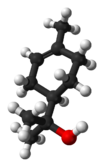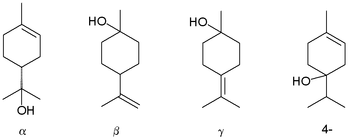- Terpineol
-
alpha-Terpineol 
 2-(4-Methyl- 1-cyclohex- 3-enyl) propan- 2-olOther namesalpha-Terpineol
2-(4-Methyl- 1-cyclohex- 3-enyl) propan- 2-olOther namesalpha-Terpineol
α-Terpineol
p-Menth- 1-en-8-ol
α,α,4- Trimethylcyclohex- 3-ene- 1-methanol
Terpene alcoholIdentifiers CAS number 98-55-5 
ChemSpider 13850142 
UNII 21334LVV8W 
ChEBI CHEBI:22469 
ChEMBL CHEMBL507795 
Jmol-3D images Image 1 - C\C1=C\CC(CC1)C(O)(C)C
Properties Molecular formula C10H18O Molar mass 154.25 g/mol Density 0.9338 g/cm3 Melting point 18 °C
Boiling point 219 °C
81-82 °C at 4.5 mmHgHazards MSDS External MSDS NFPA 704  (verify) (what is:
(verify) (what is:  /
/ ?)
?)
Except where noted otherwise, data are given for materials in their standard state (at 25 °C, 100 kPa)Infobox references Terpineol is a naturally occurring monoterpene alcohol that has been isolated from a variety of sources such as cajuput oil, pine oil, and petitgrain oil[1]. There are three isomers, alpha-, beta-, and gamma-terpineol, the last two differing only by the location of the double bond. Terpineol is usually a mixture of these isomers with alpha-terpineol as the major constituent.
Terpineol has a pleasant odor similar to lilac and is a common ingredient in perfumes, cosmetics, and flavors. α-terpineol is one of the two most abundant aroma constituents of lapsang souchong tea; the α-terpineol originates in the pine smoke used to dry the tea.[2]
Although it is naturally occurring, terpineol is commonly manufactured from the more readily available alpha-pinene.
In one study, an alternative route starting from d-limonene was demonstrated[3]:
Limonene is reacted with trifluoroacetic acid in a Markovnikov addition to a trifluoro acetate intermediate, which is easily hydrolyzed with sodium hydroxide to α-terpineol with 76% selectivity. Side-products are the β-terpineol in a mixture of cis-isomer and trans isomer and 4-terpineol.
References
- ^ Merck Index, 11th Edition, 9103.
- ^ Shan-Shan Yao; Wen-Fei Guo; YI Lu; Yuan-Xun Jiang, "Flavor Characteristics of Lapsang Souchong and Smoked Lapsang Souchong,a Special Chinese Black Tea with Pine Smoking Process", Journal of Agricultural and Food Chemistry, Vol. 53, No.22, (2005)
- ^ A Practical Synthesis of d--Terpineol via Markovnikov Addition of d-Limonene Using Trifluoroacetic Acid Yoshifumi Yuasa and Yoko Yuasa Org. Process Res. Dev.; 2006; 10(6) pp 1231 - 1232; (Article) doi:10.1021/op068012d
External links
Categories:- Flavors
- Alcohols
- Monoterpenes
- Alkenes
Wikimedia Foundation. 2010.



